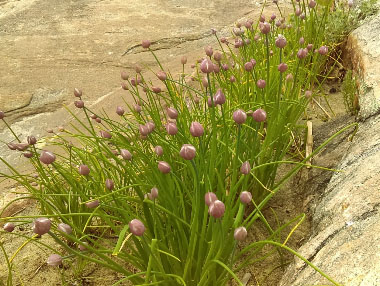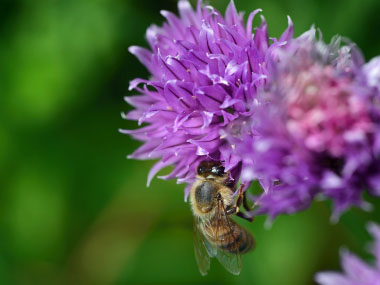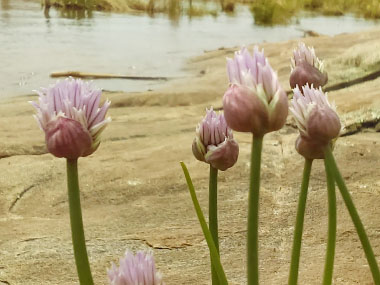





To support our efforts please browse our store (books with health benefits, etc.).
Wild chives are native to North America, but they have also escaped from cultivation, making it difficult to separate the native populations from the cultivated variety. They are easy to spot and their scent is just like cultivated chives. They are in the Alliaceae family and have a long history of being used medicinally. The most common medicinal use of chives has been in treating coughs and colds. The juice was usually boiled down to a thick syrup. They have been used to aid in the stimulation of the appetite and to help with digestion.
Distinguishing Features
Wild chives are very distinct and easy to spot when foraging. One flower head is at the apex of the stem. They are notably thin, tubular, almost grass-like, dark green leaves which typically grow in dense clumps to 30cm (12"). The scent is notably onion-like.
Flowers
Individual flowers have a tubular-bell-shape with up to about 30 small flowers forming one round dense inflorescence. Before opening, the inflorescence is surrounded by a papery bract. Each flower petal measures 7 to 15 mm (up to 1/2 ") long and can be blue to to purple or pink to red. They are in bloom anywhere from May to August. Tepals measure 8 to 12 mm (amost 1/2") long, are elliptic to lanceolate, pointed with the tips bent out. The two bracts are lanceolate to broadly ovate, and they are short-pointed. The seeds are produced in a small three-valved capsule, maturing in summer.
 Fields
of Nutrition has medicinal benefits and vitamin/mineral content of Wild Chives.
Fields
of Nutrition has medicinal benefits and vitamin/mineral content of Wild Chives.
Leaves
Wild chive leaves grow only from the base of the plant. The leaf blade is extremely narrow and linear (very narrow with more or less parallel sides), and are light to darkish green. They can grow anywhere from 20 to 60cm (8 to 24") long and anywhere from 1 to 7 mm thick.
Height
This plant can get grow anywhere from 20 to 60 cm (8 to 24") tall.
Habitat
Native populations usually inhabit river or lake shores, while the introduced populations tend to be in fields, meadows, and along roadsides.
Edible Parts
Wild chives can be used like its close cousin, domestic chives, for flavoring salads, vegetables and meat dishes. The flowers, leaves, stems and bulbs are edible.
Similar Plants
Wild Garlic.
Winter Survival Food Handbook

PDF Plant Magazines
Types of Wild Food
Geographic Zones Seasons
Disclaimer
EdibleWildFood.com is informational in nature. While we strive to be 100% accurate, it is solely up to the reader to ensure proper plant identification. Some wild plants are poisonous or can have serious adverse health effects.
We are not health professionals, medical doctors, nor are we nutritionists. It is up to the reader to verify nutritional information and health benefits with qualified professionals for all edible plants listed in this web site. Please click here for more information.
Why Edible Wild Food?
- Food costs are rising
- Free, wild food is readily abundant
- Wild food adds nutrition to your diet
- Wild food can help treat various medical conditions





